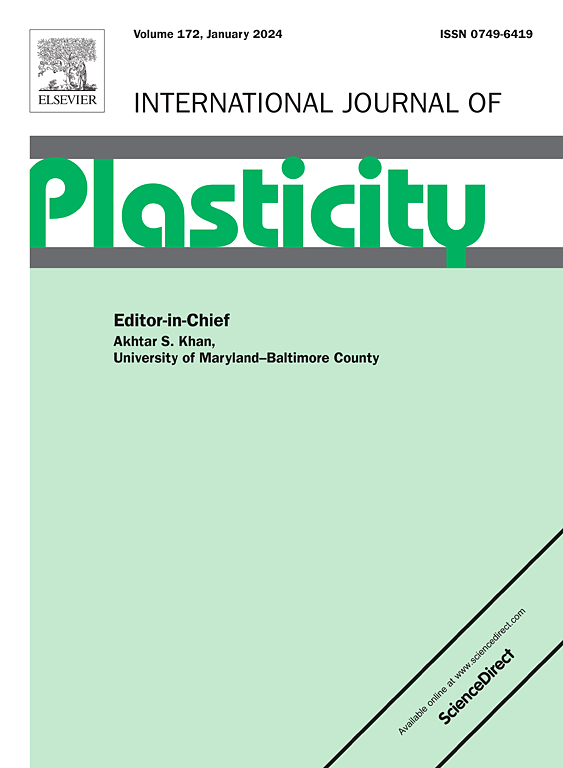考虑Re效应的镍基单晶高温合金两相显微组织结晶塑性本构模型
IF 9.4
1区 材料科学
Q1 ENGINEERING, MECHANICAL
引用次数: 0
摘要
镍基单晶高温合金(NBSCSs)独特的两相组织赋予了其优异的高温力学性能,促进了其在涡轮叶片中的应用。适量添加铼(Re)可以通过影响两相组织内的位错演化和减轻漂流来进一步提高合金的力学性能。本工作旨在定量地将两相微观结构中的位错演化和漂流与nbscs的宏观力学行为联系起来。为此,构建了由水平和垂直基质通道包围的立方沉淀物构成的代表性体积元(RVE),并采用了基于小微扰分析的微力学均质方法。为了在保持合理精度的同时提高计算效率,提出了一种近似算法。在此基础上,建立了一种基于两相微观结构的晶体塑性(CP)本构模型,该模型包含了再影响位错演化机制,并考虑了两相微观结构(即筏化)的再影响演化。该模型采用统一的本构参数集,成功地预测了nbscs在不同温度、加载速率和加载方向下的瞬时塑性和长时间蠕变行为。值得注意的是,该CP模型同时考虑了Re掺杂对位错演化和漂移的影响,显著增强了其描述nbscs力学行为的能力。本文章由计算机程序翻译,如有差异,请以英文原文为准。


Two-phase microstructure-based crystal plasticity constitutive model for nickel-based single crystal superalloys incorporating Re effects on rafting and dislocation evolution
The unique two-phase microstructure of nickel-based single crystal superalloys (NBSCSs) imparts exceptional high-temperature mechanical properties, promoting the use of NBSCSs for turbine blades. A moderate addition of rhenium (Re) can further enhance the mechanical properties by influencing dislocation evolution within the two-phase microstructure and mitigating rafting. The present work aims to quantitatively correlate dislocation evolution and rafting in the two-phase microstructure with the macroscopic mechanical behavior of NBSCSs. To this end, a representative volume element (RVE) consisting of a cubic precipitate surrounded by horizontal and vertical matrix channels is built, and a micromechanical homogenization method based on small perturbation analysis is adopted. To improve the computational efficiency while maintaining a reasonable accuracy, an approximate algorithm is proposed. Based on this, a two-phase microstructure-based crystal plasticity (CP) constitutive model that incorporates Re-influenced dislocation evolution mechanisms and accounts for Re-influenced evolution of the two-phase microstructure (i.e., rafting) has been developed. Using a unified set of constitutive parameters, this CP model successfully predicts both the instantaneous plasticity and prolonged-time creep behaviors of NBSCSs under various temperatures, loading rates and loading orientations. It is noteworthy that the influence of Re doping on both dislocation evolution and rafting is considered in the present CP model, significantly enhancing its ability for describing the mechanical behavior of NBSCSs.
求助全文
通过发布文献求助,成功后即可免费获取论文全文。
去求助
来源期刊

International Journal of Plasticity
工程技术-材料科学:综合
CiteScore
15.30
自引率
26.50%
发文量
256
审稿时长
46 days
期刊介绍:
International Journal of Plasticity aims to present original research encompassing all facets of plastic deformation, damage, and fracture behavior in both isotropic and anisotropic solids. This includes exploring the thermodynamics of plasticity and fracture, continuum theory, and macroscopic as well as microscopic phenomena.
Topics of interest span the plastic behavior of single crystals and polycrystalline metals, ceramics, rocks, soils, composites, nanocrystalline and microelectronics materials, shape memory alloys, ferroelectric ceramics, thin films, and polymers. Additionally, the journal covers plasticity aspects of failure and fracture mechanics. Contributions involving significant experimental, numerical, or theoretical advancements that enhance the understanding of the plastic behavior of solids are particularly valued. Papers addressing the modeling of finite nonlinear elastic deformation, bearing similarities to the modeling of plastic deformation, are also welcomed.
 求助内容:
求助内容: 应助结果提醒方式:
应助结果提醒方式:


